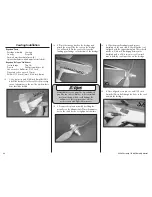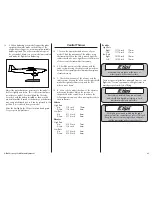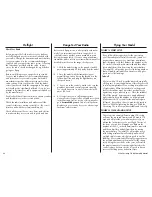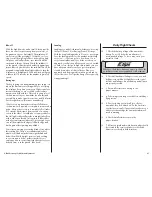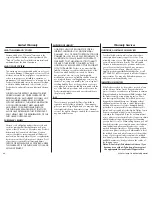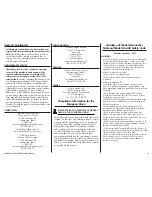
26
E-flite Shoestring 15e ARF Assembly Manual
preflight
Check your Radio
Before going to the field, make sure your batteries
are fully charged per the instructions included with
your radio. Charge the transmitter and motor battery
for your airplane. Use the recommended charger
supplied with your particular radio system, following
the instructions provided with the radio. In most
cases, the radio should be charged the night before
going out flying.
Before each flying session, range check your radio.
See your radio manual for the recommended range
and instructions for your radio system. Each radio
manufacturer specifies different procedures for their
radio systems. Next, run the motor. With the model
securely anchored, check the range again. The range
test should not be significantly affected. If it is, do not
attempt to fly! Have your radio equipment checked out
by the manufacturer.
Double-check that all controls (aileron, elevator, rudder
and throttle) move in the correct direction.
Check the radio installation and make sure all the
control surfaces are moving correctly (i.e., the correct
direction and with the recommended throws).
Check all the control horns, servo horns, and clevises
to make sure they are secure and in good condition.
Range Test your Radio
Before each flying session, and especially with a new
model, it is important to perform a range check. It
is helpful to have another person available to assist
during the range check. If you are using a Spektrum
™
transmitter, please refer to your transmitter’s manual for
detailed instructions on the range check process.
1. With the model resting on the ground, stand 30
paces (approximately 90 feet) away from the model.
2. Face the model with the transmitter in your
normal flying position. Ensure the throttle is in the
full down position and plug the flight battery into
the speed control.
3. As you move the controls, watch to be sure the
airplane’s motor and controls operate smoothly.
You should have total control of the model at 30
paces (90 feet).
4. If control issues exist, call the appropriate
Horizon Product Support office (see addresses listed
in the Warranty Services section of this manual) or
go to
horizonhobby.com
to find a local Spektrum
distributor in your country for service when using a
Spektrum
™
radio system.
Flying your Model
pOWER 15 SpORT SETUp
If you followed the suggestions for the sport setup,
you’ll have adequate control throws to do just about
any aerobatic maneuver you want from an airplane
that is designed to fly fast. Balance the airplane at the
2
3
/
8
inches (60mm) mark to start with and then adjust
fore and aft from there by moving the motor battery.
The initial CG will provide a very solid feeling airplane
that will readily stall with full up elevator, which gives
good control for landings.
Take-off
Use care with a 10-inch propeller mounted, especially
off the grass. A smooth application of throttle will result
in a fairly straight takeoff run, needing a small amount
of right rudder. When the tailwheel is on the ground
(before the tail has risen) it provides good authority
against any torque-induced yaw.... Once the tailwheel
lifts off the ground, be prepared to apply additional
right rudder to keep the airplane on a straight path.
It takes about 8–10 seconds for the airplane to gain
full speed, but you don’t have to wait for this speed to
have fun. With the light wing loading, you’ll find the
Shoestring 15e to be very maneuverable and fun to fly.
pOWER 25 1250Kv RACING SETUp
This setup is an entirely different animal. This setup
will raise the top speed from around 80 mph to 115
mph and will provide you with many hours of pure
adrenaline (at 4 minutes or so per flight). The size of
the loops you can do will amaze you. Balance the
airplane at the 2
3
/
8
inches (60mm) mark to start with
and then adjust fore and aft from there by moving
the motor battery. The initial CG will provide a very
solid feeling airplane that will readily stall with full
up (high-rate) elevator, which gives good control for
landings. We recommend following the suggestions on
the pushrod attachment in the manual for the racing
setup. Using the inner holes at the servo will result in
the greatest amount of torque being delivered to the
control surface. At these speeds, it is good to have a
reserve of holding power and extra torque.











